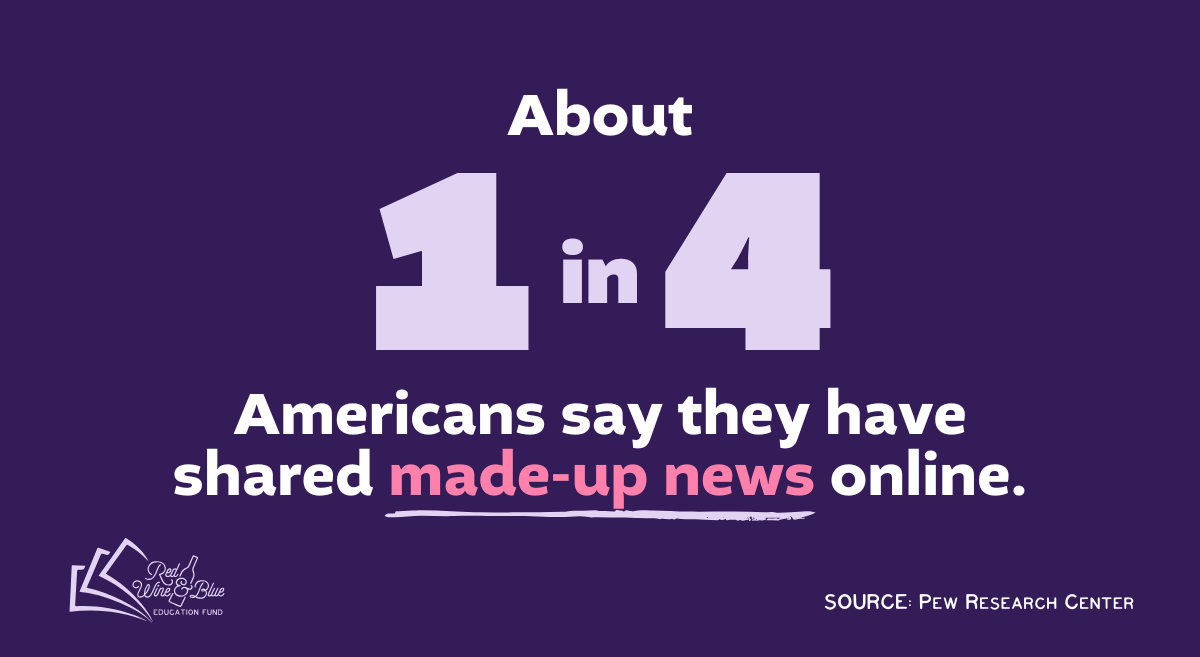Whether we prefer Facebook or Instagram, TikTok or Substack, we’re all scrolling our feeds regularly (maybe more often than we should!). Social media has become a big part of our lives. It has immense power for good, like exposing us to new points of view and connecting us with our community. But social media also gives bad actors an opportunity to take advantage of us by spreading disinformation.
A healthy democracy needs us, its citizens, to be accurately informed, so let’s learn more about disinformation and how we can fight it.
What is disinformation and why is it dangerous?
Disinformation is false information that is being spread on purpose in order to mislead people. It’s different from misinformation, which is inaccurate information being spread without the awareness that it’s not true. But since we can’t always tell if the intent is there or not, we can tackle both in the same way.
First, it’s important to recognize that disinformation is spread by bad actors. These can be foreign adversaries or domestic agitators. They can be governments, organizations or groups, or individuals. They all have the same goal: To mislead and manipulate us in order to divide us. They want to sow distrust among us so that we don’t trust each other, our institutions like schools and courts, and our professionals like teachers, lawyers, doctors, and scientists. While uniting us against common enemies, they promote their points of view and interests, often for political power and financial gain.
We know that bad actors are using disinformation to influence our elections. And Artificial Intelligence (AI) tools are making it easier for anyone to create disinformational content. Unfortunately, social media companies are reducing their fact-checking efforts, and the Trump administration is ending federal efforts to fight disinformation online. So it’s increasingly up to us to keep disinformation from spreading.
How Disinformation works (because we can all fall for it)
Spotting disinformation can be tough because it comes in many of the same forms as legitimate information or entertainment. Disinformation can be delivered through:
- Memes or other social media graphics.
- Content disguised as a news article.
- Real news articles (even journalists might include disinformation in their work!).
- Editorials, opinion pieces, and blogs (they have less stringent standards for fact-checking and data-sourcing than journalism does).
- Manipulated or AI generated photos or videos.
- Selected edits of photos, screenshots, or videos removed from their original context.
- Satire presented as fact.
Disinformation thrives in places where people are either too naive or overly confident about our abilities to spot it, but we’re all susceptible! It’s designed to tap into our “fast brain,” the part of our brain that runs on autopilot and emotions, not rationality. Disinformation is designed to elicit an emotional response — shock, anger, fear, horror, joy, or amusement — so that we react and share it quickly without thinking critically about it.
Disinformation is bolstered by the fact that social media is designed to make spreading information impulsive and easy. The algorithms boost content that has lots of reactions and clicks, and those are all driven by that same emotional response.
We also all have confirmation bias — the tendency to believe something if it reinforces or aligns with our current beliefs and values. So if we see something that supports our beliefs, we’re more likely to share it without fact-checking first. Disinformation is designed to work faster than our ability to spot and analyze it, so that’s exactly what we have to do to fight it.
How to stop disinformation from spreading.
It takes work and some reconditioning of our habits, but we can train ourselves to recognize disinformation. Now that we understand that it taps into our “fast brain,” we can be intentional about scrolling social media with our “slow brain” instead, using our reasoning and critical thinking skills. Here are some standards we can use:
- Remember that everything online can be false or manipulated.
- Be aware of our biases.
- Pause and investigate further when something quickly elicits an emotional response.
- Assess who is sharing the information. Are they a real person? Are they reliable? Could they be a bot or fake account?
- Fact-check everything — especially if it elicited strong emotions or seems sensational — using sites like factcheck.org or snopes.com.
- Assess the source of information. Is there a source? Is it a primary source? Is it reliable?
- Check a few reputable sources to see if they have the same information.
- Don’t share if you can’t verify or if it isn’t from a trusted source.
- Don’t repeat disinformation, even if you are trying to debunk it. You don’t want to spread it further, and it’s better to just share the facts!
Our democracy depends on us being informed with accurate information. In this era where real news is being called “fake news” and actual fake news is spreading like wildfire, we can all use these tips to spot and stop disinformation.


